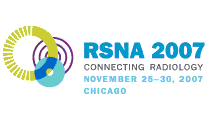
Abstract Archives of the RSNA, 2007
SSM06-04
Solid Hypervascular Liver Lesions: Accurate Identification of True Benign Lesions on Delayed Hepatobiliary Phase MR Imaging after Gadobenate Dimeglumine
Scientific Papers
Presented on November 28, 2007
Presented as part of SSM06: Gastrointestinal (Liver: Focal Lesions)
Giovanni Morana MD, Presenter: Nothing to Disclose
Luigi Grazioli MD, Abstract Co-Author: Research grant, Bracco Group
Guenther Karl Schneider MD, PhD, Abstract Co-Author: Nothing to Disclose
Maria Pia Bondioni MD, Abstract Co-Author: Nothing to Disclose
Andrea Guarise MD, Abstract Co-Author: Nothing to Disclose
Niccolo Faccioli MD, Abstract Co-Author: Nothing to Disclose
Miles A. Kirchin PhD, Abstract Co-Author: Employee, Bracco Group
et al, Abstract Co-Author: Nothing to Disclose
et al, Abstract Co-Author: Nothing to Disclose
To determine the value of hepatobiliary phase MR imaging after gadobenate dimeglumine (MultiHance, Bracco) for accurate identification of true benign hypervascular liver lesions.
Retrospective assessment was performed of 468 patients with 785 lesions (267 focal nodular hyperplasia [FNH], 30 nodular regenerative hyperplasia [NRH], 124 hepatic adenoma/liver adenomatosis [HA/LA], 211 hepatocellular carcinomas [HCC], 11 fibrolamellar-HCC [FL-HCC], 16 peripheral cholangiocarcinomas [PCC], 17 capillary hemangiomas [CH] and 109 hyper- or hypovascular metastases) who underwent enhanced MR imaging with 0.05 mmol/kg gadobenate dimeglumine. Histological confirmation was available for all lesions except most FNH whose diagnosis was based on characteristic enhancement and two-year follow-up. Pre- and post-contrast T1-weighted images acquired during the dynamic and delayed hepatobiliary (1-3h) phases were evaluated for lesion enhancement (hypo-, iso-, hyperintensity). Lesion enhancement was compared with histology findings and values for sensitivity, specificity, accuracy, PPV and NPV were determined.
On hepatobiliary phase imaging 96.6% of FNH, 100% of NRH, 5.6% of HA/LA, 21.8% of HCC and 2.7% of metastases appeared hyper- or isointense, whereas 3.4% of FNH, 94.4% of HA/LA, 78.2% of HCC, 100% of FL-HCC, 100% of PCC, 100% of CH and 97.2% of metastases appeared hypointense. Assuming delayed phase lesion iso/hyperintensity as indicating true lesion benignity (FNH/NRH) values for sensitivity, specificity, accuracy, PPV and NPV of 97.0%, 88.5%, 91.7%, 83.7% and 98.0%, respectively, were obtained for identification of true benign lesions.
Hepatobiliary phase imaging after 0.05 mmol/kg gadobenate dimeglumine is highly accurate for distinguishing true benign focal liver lesions from other lesions. Lesions that are hypointense on hepatobiliary phase imaging should be considered for biopsy.
Delayed hepatobiliary phase imaging is a unique property of gadobenate dimeglumine among Gd agents in the USA which can be utilised to improve lesion characterization and differential diagnosis.
Morana, G,
Grazioli, L,
Schneider, G,
Bondioni, M,
Guarise, A,
Faccioli, N,
Kirchin, M,
et al, ,
et al, ,
Solid Hypervascular Liver Lesions: Accurate Identification of True Benign Lesions on Delayed Hepatobiliary Phase MR Imaging after Gadobenate Dimeglumine. Radiological Society of North America 2007 Scientific Assembly and Annual Meeting, November 25 - November 30, 2007 ,Chicago IL.
http://archive.rsna.org/2007/5004945.html

